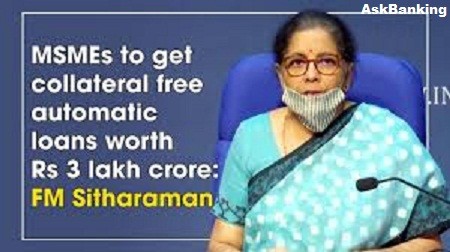Collateral free loans under Government Rs 20 lakh crore stimulus package – If you believe on the analysis of Bank of America (BofA Securities), Government-owned banks’ non-performing assets (NPA) could go up by 2-4 percent of the credit in the present COVID pandemic scenario. The real onus of rolling out this 20 lakh crore economic package promptly falls on state-run banks and institutions like NABARD. This will be really a tricky situation for these banks because in a faltering economy, a good chunk of these loans could go bad later. BofA says, banks are really in need of recapitalization requirement of $7-15 billion (Rs 1.14 lakh crore at the upper end).
It is also important to analyze that the much of the Rs 20 lakh crore economic package announced so far by Union finance minister Nirmala Sitharaman include bank loans and interest rate subsidies. In reality, there is very little fresh stimulus in the economy from the government.
Read – MSMEs New Definition, Turnover Based Classification Introduced
Key announcements made so far under stimulus package
1. Banks will disburse Rs 3 lakh crore worth collateral-free loans to micro, small and medium enterprises (MSMEs) backed by government guarantee.
2. These loans will have one-year moratorium and a four-year repayment period. Also, Rs 75, 000 crore lending has been earmarked for NBFCs and MFIs.
3. Another Rs 2 lakh crore concessional credit for 2.5 crore farmers through new Kisan Credit Card (KCC) route
4. Rs 30,000 crore emergency working capital fund through NABARD
5. 2 percent interest subvention on Mudra loans less than Rs 50,000 and
6. Rs 5,000 crore credit facility for street vendors
How to meet the targets ?
Post announcement of the government package, the public sector banks are under tremendous pressure. They will be forced to kickstart the disbursement of loans to meet the targets set by the government.
In general, whenever a government scheme is announced, whether it be a loan waiver or direct lending to MSMEs or loan waiver, PSBs are given informal targets. It has started since the launch of Jan Dhan bank accounts and back-to-back loan waiver schemes across states.
Is the collateral free loan a smart decision ?
Currently, banking system is already reeling under the COVID-19 crisis. Almost all the banks are showing the signs of stress in customer segments. Most of the banks have made upfront provisions i.e. kept funds aside to cover risky loans, to cover COVID-19 induced losses. At such time when banks are already facing a crisis scenario, collateral free loans and fresh KCC loans are likely to put more pressure on the system.
Read – No Takers for RBI’s 3-Month Loan EMI Moratorium
Government guarantee on collateral free loan
Collateral-free loans to MSMEs carry high potential risk in the banking system even with the government guarantee. Under this scheme of Rs 45,000 crore partial credit guarantee,the government has promised to take only 20 percent losses in the event of default. Banks will have to take the risk for remaining 80 percent.
There is no say by the government to stop the misuse of the Collateral-free loans which carry a risk of companies misusing the government scheme in collusion with local bank officials and politicians. In the past, this has happened rampantly in the co-operative banking sector. There is no scope of recovery since there is no collateral against the loans.
Other Issues related to Collateral Free Loan
- There are strong possibility of banks overlooking the creditworthiness of the borrower in a hurry to meet the government targets.
- There is no proper mechanism to assess the end use of these loans and strict conditions linked to performance and staff retention
- The collateral free loans may not yield the desired results. The demand is also very loaw and in a slowing economy, such loans could emerge as a fresh risk to the banking system eventually.
Why NPA ?
PSB banks have given a good chunk of loans under COVID-19 relief package. It will substantially increased the capital requirement of PSBs , once the loan moratorium period is over. There are big chances of good percentage of existing loans turning bad.
How can the government fund PSBs’?
Currently government is cash-starved. How do they recapitalize the government banks ? The government has not yet announced a plan on how to recapitalize these banks. The PSB banks are in need of urgent capital support.
There are big chances that the government could use RBI’s revaluation reserves to capitalize banks. According to BofA, the RBI’s revaluation reserves of Rs 9.6 lakh crore can also be utilised to recapitalise banks.
Read – What is Collateral Security ?
Opinion
Just capitalizing banks isn’t enough. Government needs to find a way to address the existing bad loans of around Rs 8 lakh crore. The collateral free loans to be granted on the tier basis to healthy MSMEs and should not be generalized for each category of borrowers.
The end utilization of the loans much be verified through the third party and such loans granted must be audited by CAG.
This is well known fact that the NPA are unlikely to be resolved under such low economic situation. There are chances of additional fresh chunk of NPAs due to relief granted as collateral free loans or KCC.As of now, the government is silent on this part.
Read – Should you go for COVID-19 personal Loan ?
